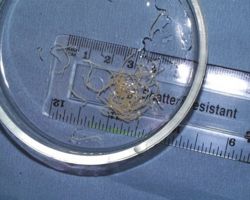Lungworm - Donkey
Lungworm - Dictyocaulus arnfieldi
Introduction
This equine nematode parasite infecting the respiratory tract has worldwide distribution, with high infection prevalence in donkeys. Donkeys are assumed to be the natural host of this parasite. It is commonly patent in the donkey, whereas in the horse patency is uncommon. The worms are well adapted to living in the donkey where they grow to maturity and lay eggs, while in most cases presenting few clinical signs. In the horse the parasite rarely develops to maturity, but severe tissue reaction stimulates chronic coughing. There are, however, reports that D. arnfieldi can occasionally produce patent infection in the horse (Round, 1976).
The life cycle of the parasite involves ingestion of infective third stage larvae that migrate via the mesenteric lymph nodes and thoracic duct. Larvae infiltrate the alveoli causing low-grade inflammation. Adult worms grow up to 8 cm long in the bronchi and can block the small airways. The pre-patent period is approximately 13 weeks. The first-stage larvae are passed in the faeces and take as little as three days to develop into infective third-stage larvae (L3). L3 can survive for prolonged periods in shady conditions.
Diagnosis

Donkeys generally suffer little, even from heavy infections, but serve as a reservoir of infection for horses. Thus, this parasite is more of a concern for co-grazing horses than the donkeys themselves.
Clinical signs
Donkeys tolerate even a large infestation of lungworms without apparent signs.
The signs include:
- Harsher lung sounds may be detected on auscultation
- Lung changes may exacerbate other respiratory diseases, such as influenza
- (In the horse, the signs commonly associated with Dictyocaulus include a chronic cough and tachypnoea)
Laboratory tests
As clinical signs are generally mild in donkeys, diagnosis is made by finding larvae in the faeces using a modified Baermann technique. In the horse, the diagnosis is often based on a history of co-grazing with donkeys or response to treatment. The definitive diagnosis in the horse relies upon finding larvae and eosinophils in a tracheal wash or bronchioalveolar lavage.
Treatment
- Ivermectin or moxidectin will effectively eliminate lungworms from the donkey. Less effective options include mebendazole, albendazole and thiabendazole. Due to its long persistence, the parasite is hard to remove from paddocks, and it is advisable to include pasture management in treatment regimes, using different pasture, harrowing, crop rotation, ploughing etc. Moxidectin use in donkeys is under the cascade system as this product is not licensed for use in donkeys in the UK.
Control
Dictyocaulus arnfieldi alone rarely causes clinical problems in donkeys, although it may exacerbate respiratory infections due to other causes. Due to the reported incidence of this parasite in donkeys, particularly when they are co-grazed with horses, where lungworm can cause significant clinical problems, a general control strategy (e.g. with ivermectin) is recommended. Donkeys entering the Donkey Sanctuary are isolated for a minimum of six weeks and treated with ivermectin. Since it is reported that lungworm larvae may survive in the subsoil for up to two years, pasture contamination must be considered. Harrowing permanent pasture will reduce larvae and ploughing or crop rotation will eliminate larvae. Grass in hedgerows may, however, become a source of reinfection.
Clayton and Trawford (1981) advise that annual treatment of resident donkeys for lungworm in spring, combined with isolation and treatment of new arrivals, should reduce pasture burdens of infective L3.
Literature Search
Use these links to find recent scientific publications via CAB Abstracts (log in required unless accessing from a subscribing organisation).
Lungworm in donkeys publications
References
- Thiemann, A. (2008) Respiratory problems In Svendsen, E.D., Duncan, J. and Hadrill, D. (2008) The Professional Handbook of the Donkey, 4th edition, Whittet Books, Chapter 7
- Trawford, A. and Getachew, M. (2008) Parasites In Svendsen, E.D., Duncan, J. and Hadrill, D. (2008) The Professional Handbook of the Donkey, 4th edition, Whittet Books, Chapter 6
- Clayton, H.M., Trawford, A.F. (1981). ‘Anthelmintic control of lungworms in donkeys’. Equine Veterinary Journal 13(3). pp 192-194.
- Round, M.C. (1976). ‘Lungworm Infection – (Dictyocaulus arnfieldi) of horses and donkeys’. Veterinary Record 99. (20). pp 393-395.
|
|
This section was sponsored and content provided by THE DONKEY SANCTUARY |
|---|
